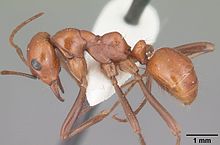Polyergus lucidus
| Polyergus lucidus | |
|---|---|

| |
| Scientific classification | |
| Kingdom: | |
| Phylum: | |
| Class: | |
| Order: | |
| Family: | |
| Subfamily: | |
| Genus: | |
| Species: | P. lucidus
|
| Binomial name | |
| Polyergus lucidus Mayr, 1870
| |
Polyergus lucidus is a species of slave-making ant in the subfamily Formicinae. It is endemic to the eastern United States. It is an obligatory social parasite, unable to feed itself or look after its brood and reliant on ants of another species of the genus Formica to undertake these tasks. Parasitic ants are known as "dulotics" (from the Greek "dulos" meaning a slave) and the ants they parasitise are known as "hosts".
Description
Polyergus lucidus is part of a group of six orange-red or dark red species of ant, mostly from eastern North America, that have long, often dark-coloured appendages and few hairs on the dorsal surface of the gaster. The worker is 5.7 to 7.1 millimetres (0.22 to 0.28 in) long and has a head longer than it is wide, crowned with about a dozen short setae (bristles). It is red with the legs and the tip of the gaster often being tinged with brown. The specific name lucidus means "shiny" and this ant is the shiniest in the group and has a glossy mesonotum and gaster, and a moderately shiny head.[1]
Behaviour

Polyergus lucidus is incapable of feeding itself or rearing its young without assistance. Like other members of its genus, it raids the nests of another species of ant and carries off the pupae to be reared in the dulotic nest where, when they emerge, they will function as workers. In the case of Polyergus lucidus, the host species is nearly always Formica incerta,[1]but Formica nitidiventris and Formica schaufussi have also been found working in dulotic nests of Polyergus lucidus.[2] It has been shown that colonies of Polyergus lucidus will selectively raid nests of the slave species already present in the dulotic nest, the exception being when there are no such nests within the vicinity. On the odd occasion when the nest of a different ant species was raided, the pupae brought back to the dulotic nest were likely to be consumed. It is unclear how the worker dulotics obtain their preferences but it is probable that they are imprinted.[2]
Distribution
Polyergus lucidus is native to the eastern United States and occurs almost everywhere that its host species is found. Its range extends from New England and Wisconsin southwards to the Carolinas and Missouri but it is absent from Kansas and Nebraska. It is generally found in rough grassland.[1]
References
- ^ a b c Trager, James C. (2013). "Global revision of the genus Polyergus". Zootaxa. 3722 (4): 501–548. doi:10.11646/zootaxa.3722.4.5.
- ^ a b Goodloe, Linda; Sanwald, Raymond; Topoff, Howard (1987). "Host specificity in raiding behavior of the slave-making ant, Polyergus lucidus". Psyche. 94: 39–44. doi:10.1155/1987/47105.
{{cite journal}}: CS1 maint: multiple names: authors list (link) CS1 maint: unflagged free DOI (link)
- Social Insects Specialist Group 1996. Polyergus lucidus. 2006 IUCN Red List of Threatened Species. Downloaded on 10 August 2007.
External links
 Media related to Polyergus lucidus at Wikimedia Commons
Media related to Polyergus lucidus at Wikimedia Commons

